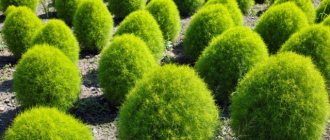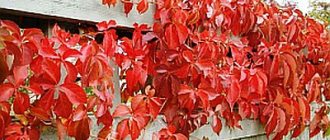Miscanthus, also called fantail, is closely related to sugar cane and is directly related to the genus of herbaceous perennial plants of the Poa family (cereals). Under natural conditions, such a plant can be found in tropical and subtropical regions of Australia, Asia and Africa. This genus includes approximately 40 species. This ornamental grass is very popular among gardeners. In landscape design, miscanthus is used to decorate lawns and decorative ponds, and this grass is also indispensable when creating dry floral compositions.
Features of Miscanthus
Miscanthus is a perennial plant and can reach a height of 0.8 to 2 meters. Its creeping rhizomes in some cases reach a depth of six meters. Stems are erect. The width of the leathery scale-like leaf plates is from 0.5 to 1.8 centimeters. The fan-shaped panicles, 10–30 centimeters long, include spikelets. This plant is distinguished by its unpretentiousness, endurance and environmental safety. This ornamental grass is also used as fuel for power plants, since when it is burned, a large amount of energy is released, and very little ash is formed, because the raw material contains a small amount of moisture.
Miscanthus Sp - video review from Greensad
Planting miscanthus in open ground
What time to plant
Miscanthus must be planted in the spring after the soil has warmed up well (from the last days of March to the second half of May). This cereal is heat-loving; therefore, to plant it, you need to choose sunny, well-warmed areas that are protected from the cold wind. Such plants need a sufficient amount of water, so moist nutrient soil located in the coastal zone is best suited for them. Miscanthus does not have any special requirements for the soil, but it grows and develops very poorly on heavy clay and sand.
How to plant
To plant, you will need to purchase adult seedlings from a specialized store. The fact is that this cereal has a fairly long period of active growth. It should be taken into account that such a plant begins to grow only after the air warms up to 25 degrees. In this regard, if you plant a young seedling, then it simply will not have enough time before the onset of frost to take root well and prepare for wintering. An adult seedling can easily withstand even a frosty winter period if it is provided with good shelter. The volume of the planting hole should not be much larger than the size of the seedling's root system. First, a layer of nutrient soil is poured into the hole, and then the seedling is placed in it. The hole is filled with soil, constantly compacting it so that there are no voids left. The planted plant must be watered very well.
Miscanthus chinensis Gracillimus (Gracimillus)
Other names
Chinese reed, Chinese fantail, Chinese grass
Origin
The homeland of Chinese miscanthus is the Far East. The Gracillimus variety was bred artificially.
Application
Gracillimus is a late-blooming variety (September - October) with copper-red ears and golden leaves in autumn.
Miscanthus chinensis is a perennial herbaceous plant from the Poaceae family. Used in landscape design for park and coastal areas. More often it is planted singly or at some distance from other miscanthus.
Dried inflorescences are used in floristry.
Features of growth
The height of an adult plant is 2 meters. Forms large clumps from which long leaves grow. During the flowering period, ears rise on long stems.
Habitats
Natural habitat - Korea, Japan, China, south of Primorsky Krai. In nature, miscanthus grows in forest glades and slopes, among bushes.
Climatic conditions
Tolerates temperatures down to -23 degrees Celsius. It is better to mulch for the winter. Tolerant of minimal drought, but it is advisable to avoid it.
The soil
The plant is undemanding to soils, but will grow poorly in sandy, clayey and heavy soils.
Landing
It is better to choose a place for planting that is well lit and protected from the winds. Coastal areas are ideal.
The height of the planting pit is 50-60 centimeters. At the bottom of the hole it is necessary to place a drainage layer consisting of small crushed stone/crushed bricks and peat.
The distance between seedlings should not be less than 40 centimeters.
Immediately after planting, the tree trunk circle must be mulched with dry leaves or sawdust.
Planting is carried out in the spring, when the earth has already warmed up.
Care
The most important thing is that the miscanthus has enough moisture, so regular watering is important.
Diseases/pests
Miscanthus is very resistant, but as a preventative measure it can be treated with a fungicide solution.
Trimming
In the fall, when the leaves begin to dry out, it is better to cut them off - then the bush will look better next season.
Bark
Erect smooth dark green stems.
Leaves
Green smooth leaves, pointed. In autumn they turn golden yellow.
Bloom
Flowering occurs at the end of September - beginning of October. At this time, the bush is covered with lush panicles that rise on long stems.
The hue is first copper-red, then silver.
Caring for miscanthus in the garden
Miscanthus needs timely watering, otherwise it can dry out quickly. Particular attention should be paid to watering this cereal during dry and hot periods. This plant is recommended to be watered with a hose, and it should be as abundant as possible. In order for the ornamental grass to grow and develop normally, it needs systematic feeding, which must be moderate; for example, an excess amount of nitrogen can cause miscanthus to lodging. The planted cereals are not fed for the first year. Then, in mid-May, liquid fertilizing with nitrogen-containing fertilizers (for example, urea solution) is used. In the first half of the summer, the plants will need watering with humates, and in the second half, phosphorus-potassium fertilizer is added to the soil. The plant will also need systematic weeding for at least two years in a row, then it will get stronger and grow strongly, so the weeds in the area will stop growing on their own. It is not necessary to loosen the soil surface in the area with miscanthus.
It should also be taken into account that this grass is a very aggressive plant that can grow and survive other flowers. Therefore, even during planting, it is necessary to make special restrictions; for this, limiters are used, which can be pieces of slate or sheets of iron. They should be dug along the entire perimeter of the site, and there should not be even minimal breaks or gaps. The limiters must be dug in at least 0.2 m deep, and they must also rise above the soil surface by about 10 centimeters, which will not allow the roots of the plant to “jump” over the boundary.
There are species in which, by the end of the summer period, the leaf plates located below are lost, which makes the decorative value of this cereal somewhat reduced. To ensure that the lower “bald” part of the miscanthus is not so conspicuous, it is recommended to plant a tall hosta (0.5 to 0.6 meters) in close proximity to it, which grows very well in highly moist soil.
Almost any gardener can cope with planting miscanthus, as well as its cultivation, and this cereal will certainly become the main decoration of any garden.
Miscanthus propagation
Such a plant reacts quite negatively to transplants, but after some time in the central part of the bush the old stems begin to die off, and therefore the gardener thinks about replanting the miscanthus. As a rule, along with replanting, the plant is also propagated by dividing the bush. Division is recommended to be done in spring or summer. It should be noted that this procedure must be carried out very carefully, because the restoration of this cereal after division is very long and painful.
Miscanthus can also be grown from seeds. The seeds do not need to be prepared before sowing, but if you choose this propagation method, you should keep in mind that you will have to be patient. The fact is that such a cereal, grown from seed, reaches the peak of its decorative value only 3 or 4 years after sowing. It is recommended to sow the seeds in individual peat pots, and after the soil warms up well in spring, the miscanthus seedlings can be transplanted into open soil. However, it should be borne in mind that plants grown from seeds are not able to retain varietal characteristics.
Pests and diseases
This plant has incredibly high resistance to a wide variety of diseases and harmful insects.
Miscanthus Purpurascens
Chinese Miscanthus Purpurascens (Miscanthus sinensis Purpurascens) is a compact bush, up to 1.5 m high with peduncles. Chinese Miscanthus Purpurascens (Miscanthus sinensis Purpurascens) Chinese Miscanthus Purpurascens (Miscanthus sinensis Purpurascens) at the peak of its beauty acquires a bright crimson color. And during the flowering period, the bush is covered with silvery inflorescences. The long leaves of this plant resemble brown needles in appearance. The leaves are linear, up to 1.5 cm wide, with a thick ridge in the middle, hard, rough. Spikelets are single-flowered, up to 0.7 cm long, in loose panicles with a shortened main axis. It has a long period of decorativeness - from spring to late winter. Winter hardiness zone: 4.
Place for planting Chinese Miscanthus Purpurascens (Miscanthus sinensis Purpurascens). Prefers open sunny places (they do not bloom in shade). They feel great in waterlogged areas, but can also grow in relatively dry places without growing as much.
Soil Chinese Miscanthus Purpurascens (Miscanthus sinensis Purpurascens). Undemanding, but prefers fresh soil. Grow well on various types of soil, except sand and heavy clays.
Planting and Caring for Miscanthus Chinese Purpurascens (Miscanthus sinensis Purpurascens). Caring for this plant is relatively simple. In order to prevent unwanted intensive growth, during planting the plant should be limited artificially. The restriction should be placed around the perimeter of the planting and have a depth of at least 10 cm. But it is not necessary to deepen it too much, since the plant has a superficial root system. The top edges of the restraint should be placed approximately 5 cm above the soil level. This is due to fairly strong roots that can bypass a low barrier. If the Chinese miscanthus has formed a dense clump, it may begin to die off in the center, the reason for this is a delay in timely division. This ornamental grass must be periodically divided and replanted. Only minor fertilizing needs to be done. If there is an excess of nitrogenous fertilizers, the plant will grow very quickly and fall to the ground. Chinese miscanthus should be pruned in early spring, because its shoots have a decorative appearance even in the autumn and winter seasons. You should regularly remove shoots that are not as decorative as the bush itself. This plant really does not like being transplanted, so the best option would be to provide it with a permanent place in the garden. Reproduction of Chinese Miscanthus Purpurascens (Miscanthus sinensis Purpurascens). There are two ways to propagate miscanthus. 1. The bush should be divided in early spring. This work must be carried out very carefully and carefully, since miscanthus does not like manipulations associated with transplantation. 2. To propagate by seeds, it is necessary to sow them in the winter. They do not require pre-treatment. If you prefer this particular method of reproduction, be patient. This bush will acquire its natural beauty only after 3-4 years. Use of Chinese Miscanthus Purpurascens (Miscanthus sinensis Purpurascens) in garden design. Miscanthus is one of the most popular ornamental grasses. It is beautiful throughout the entire season: from early spring until the onset of winter cold. It is used to frame ponds and decorate lawns. Large bushes look impressive among boulders. They will perfectly serve as a hedge and become a backdrop for flowering plants.
The online store of garden plants "Garshinka" has the largest collection of plants and carefully delivers planting material from all over the world throughout Russia. We guarantee the quality and grade of the supplied material. We store plants ready for shipment in special conditions. We pack parcels in a secure manner. We notify you about shipment and control the parcel en route. We work on a 100% prepayment basis in order to reserve the best varieties for you and guarantee on-time delivery without postage or commissions.
We recommend purchasing garden plants from the Garshinka online store to experienced and novice gardeners, landscape designers and joint purchasing communities. There is a unique offer for every buyer. Here you can buy various planting materials: seedlings of roses, fruit and ornamental trees and shrubs, all groups of conifers, standard species, rhizomes of perennial flowers, bulbous plants for autumn and spring planting, lawn grass seeds, fertilizers and pest control products.
Miscanthus after flowering
There are types of miscanthus that are frost-resistant, while others simply need good shelter for the winter. If you have planted a fairly delicate variety of such an ornamental grass, then you will have to provide it with protection both from frost and from sudden changes in temperature. In the case when it gradually gets colder outside, the grass may have time to adapt, but if the frost is unexpected, then the bushes die in most cases. In order to protect such ornamental plants, it is necessary to cover the bushes with a film, placing it in a hut, while air must flow from the side parts under the cover. Then, on top of the film, you need to install 2 wooden shields, also like a hut. However, before covering the miscanthus, it is necessary to cover the area where it grows with a very thick layer of mulch, which can be any loose soil.
Types and varieties of miscanthus with photos and names
Giant Miscanthus (Miscanthus giganteus)
This species has long been cultivated by gardeners, and experts believe that it is a complex hybrid, but no one knows how it originated. Erect shoots can reach a height of up to 300 centimeters. The weeping leaf blades are about 0.25 m wide. They are painted dark green, with a white stripe running along the central vein. From the shoot, the leaves spread out in different directions, which in appearance is very similar to a large fountain. Flowering is observed at the end of the summer period, with light pink panicles appearing, acquiring a silvery color over time. If the summer period in the region is cold, then miscanthus may not bloom at all. Often this species is planted as an accent in the background. It should be taken into account that at the end of the summer, its lower leaves fade; therefore, the lower part of the miscanthus will need to be masked.
Chinese Miscanthus (Miscanthus sinensis)
Under natural conditions, this species can be found in Korea, Russia, China, and Japan. This perennial is a grass with a loose bush. It has a rather short rhizome, and erect shoots can reach a height of about 300 centimeters. The hard, rough linear leaf plates are approximately 15 millimeters wide and have a rough rib running along the central vein. During flowering, single-flowered spikelets appear, which can reach 0.7 centimeters in length, and they are part of loose panicles. It has been cultivated since 1875. It is not highly frost-resistant; therefore, it simply needs dry shelter, and by winter you should not forget to sprinkle the area with a thick layer of mulch. This species is most popular among gardeners and approximately 100 of its varieties are known, differing in the shape and color of the inflorescences, as well as the outline and size of the bush itself. These include both frost-resistant varieties and those that prefer to grow in warm climates.
Varieties:
- Blondeau . It can reach 200 centimeters in height. Sufficiently frost-resistant, shelter is not required for the winter.
- Variegatus . The dense bush can reach only 150 centimeters in height. Its leaf blades have white longitudinal stripes.
- Miscanthus Zebrinus (in some cases called Miscanthus Zebrinus). The variegated bush on green leaf blades has yellow stripes that are arranged transversely.
- Ferner Austin . The bush can reach 150 centimeters in height. On narrow green leaf plates along the central vein there is a white stripe, which in autumn becomes reddish-red. In August, fan-shaped panicles of a rich red color with white tips bloom; over time, they change their color to bronze-silver.
- Morning Light . The beautiful, not very tall bush has narrow leaf blades with a white edging. Flowering occurs quite late and not every year.
- Strictus . The bush reaches a height of 2.7 meters, the width of its richly colored variegated leaf blades is about 15 mm. The leaves alternately have green and rich white stripes; the loose panicles consist of single-flowered pale red spikelets.
Miscanthus sacchariflonis (Miscanthus sacchariflonis)
Under natural conditions, it can be found in Russia in damp areas from the south of the Primorsky Territory to the Amur Region, as well as in China, Korea and Japan. A bush with bare shoots can reach 200 centimeters in height. The drooping linear leaf plates are painted pale green, they are one and a half centimeters wide and about 0.6 m long. The panicles reach 0.25 m in length, and they are painted white or pink-silver. This species is a heat-loving species, so its growing season begins at the end of the spring period, but throughout the warm season its growth is characterized by high intensity. Flowering begins in July, and this grass can retain its decorative appearance until October. It is quite frost-resistant; shelter is not required for wintering, but it is better to mulch the area in case of little snow in the winter. The most popular form is Robustus; its bush is slightly larger than that of the main plant.
Garden. Ornamental grasses: miscanthus, sesleria
Ornamental grasses: about miscanthus from the personal experience of Tatyana Zheltovskaya
It took me a while to develop a friendship with these spectacular cereals. The first microscopic sections of Chinese miscanthus that fell into my hands quickly died. And for a long time I did not risk planting them again. But now I know the secrets of growing them.
- Miscanthus sacchariflonis
- Purple miscanthus (Miscanthus purpurascens)
- Chinese Miscanthus (Miscanthus sinensis)
- Rules for success in growing Chinese miscanthus
Miscanthus sacchariflonis
One day I was given two turfs of intertwined, rough, finger-thick rhizomes of Miscanthus sacchariflonis . Planted without any restrictions, they soon spread out, occupying a large space. It didn’t turn out to be a beautiful mass - only individual one and a half meter stems. But I needed powerful curtains, and I decided to use a limiter - shallow, about 15 cm, with an area of 1.5 m2.
Miscanthus is a warm-growing plant; it begins to grow only when the soil warms up well. The first two years in the spring, on warm days, I watered it with a urea solution so that sprouts appeared earlier. Then there was no need for this. An adult miscanthus plant starts at the end of May and forms a spectacular clump by mid-July. Regular flooding of my site does not affect it.
In the photo: Miscanthus sugarflower
The restriction was fully justified, but sometimes the roots “jumped” over the top, so I began to use a plastic tape 28 cm wide, leaving 5 cm at the top. Now the rhizomes inside the limiter are so intertwined that there is no soil left on the surface. Now every spring I remove part of the roots, cutting off 3-4 sods measuring approximately 15x15 cm with a shovel, and add compost on top.
By the end of summer, the lower leaves of the sugar-flowered miscanthus wither and lose their decorative effect, so you need to select companions that camouflage the bottom of the bush. of the reed grass (Stipa calamagrostis) look good
Tall, graceful, decorative throughout the season, the clethroid loosestrife (Lysimachia clethroides) quite coped with this role. But, alas, the next year he fell victim to another flood.
For now I've settled on the host 'Striptease'. It is tall (50–60 cm), with interesting foliage and, most importantly, tolerates excess moisture well.
In the photo: Miscanthus sugarflower in the garden
perennial asters look good against the background of yellow and sometimes orange foliage of miscanthus . You can plant calimeris - it blooms in July and is pleasing to the eye until October. Sugar-flowered miscanthus also looks good among shrubs. I have it sitting in a limiter among the barberries . The huge mass that this plant grows allows you to create screens from it, behind which you can hide not particularly beautiful areas of the garden. The stems of some Miscanthus sugarflower hybrids can turn purple in autumn.
Purple miscanthus (Miscanthus purpurascens)
Although I planted Miscanthus purpurea too late for a warm-season grass, in early October, there were no problems. Miscanthus purpurea overwintered well without any shelter. Wide leaves, which begin to acquire burgundy shades already in August, and strong stems that do not require support allow you to set the rhythm in mixborders or use it as a tapeworm. I have this miscanthus growing in a composition with park roses and a low hosta . The bloom of roses looks more spectacular against the background of a fountain of its cascading foliage.
Like the previous species, miscanthus purpurea is a stunningly spectacular decoration for the autumn and winter garden. Yellow-red leaves rustling in the wind create both a festive mood and an atmosphere of mystery in the garden. The strong stems of miscanthus purpurea do not fall over from wind and snowfall. Therefore, I trim them, of course, in the spring. This work is quite labor-intensive - only a good, sharp pruner can take strong stems. But you can remove them slowly, because new shoots grow quite late.
In the photo: Miscanthus purpurea
Chinese Miscanthus (Miscanthus sinensis)
My turn has come to Chinese miscanthuses . Of course, I tried to plant the most winter-hardy varieties. But you can count them on one hand, and they are rarely found on sale here. I had to take a chance and plant several more accessible, early-blooming and especially decorative ones. For a long time I raised them in a sunny garden bed, where they received timely feeding and watering. Then I began to carefully transplant them to the planned places. Only four miscanthus were planted directly into mixborders: Flamingo, Puenktchen, Sarabande and Silberspinne. It is unlikely that in central Russia the Silberspinne miscanthus will grow to the same size as in England, but it still forms a spectacular clump.
In the photo: Chinese Miscanthus (Miscanthus sinensis)
In our conditions, we have to check the winter hardiness of varieties ourselves in practice. My observations do not always coincide with data from foreign literature. So, my Sarabande fell out after the second winter. And it cannot be said that the winter was extreme. Morning Light also died several times. And they are classified as quite winter-hardy miscanthus. But the more heat-loving Flamingo and Silberspinne are leaving for their fourth winter this year. In the fall, I just cover their root system with sphagnum, and cut off the foliage in the spring - it helps to retain snow. I can’t boast that they have grown much - we are not in England after all, but small jackets are quite decorative. Over the course of five years, the spectacular bush formed overwintering in a shelter together with Puenktchen roses. So far it has never bloomed, but its decorative spotted foliage makes up for this shortcoming.
Chinese miscanthus are excellent accents; they easily fit into mixborders, are good for planting near water, and add color to the autumn and winter garden.
In the photo: Miscanthus chinensis
Variegated varieties of Chinese miscanthus with transverse stripes are very popular among gardeners: Strictus, Zebrinus, Hinjo, Puenktchen. Outwardly, they are very similar - they differ only in the brightness and shade of the stripes.
Rules for success in growing Chinese miscanthus
- Try to buy mature planting material. In our climate, we cannot provide the Chinese miscanthus with the usual long growing season, so the small delenka will not have time to grow and become stronger after transplantation. A larger plant has a margin of safety - it will be easier for it to endure a harsh winter.
- When choosing a place in the garden for Chinese miscanthus, you need to take into account that it comes from warm areas with high air humidity.
- Fill the planting hole with fertile soil and feed it with organic matter every spring. Good results are achieved by watering with humates and applying complex fertilizers.
- Chinese miscanthus does not tolerate drying out: during dry periods it needs to be watered regularly.
- It is necessary to cover for the winter not very winter-hardy varieties and those planted in fairly cold areas. Delicate varieties should be protected from sudden temperature changes. If the temperature drops gradually, the plant has time to adapt to frost. But a sharp cold snap can lead to its death. I make a simple shelter: I install a piece of plastic film as a hut so that there is ventilation on the sides. On top of the film, like a hut, I place two wooden shields. According to my observations, they effectively protect plants from thermal shock.
- In the middle zone, dividing Chinese miscanthus can only be done in spring or early summer. And in mild climates they are divided in early autumn. After division, several years will pass until the plant reaches full decorative potential.











